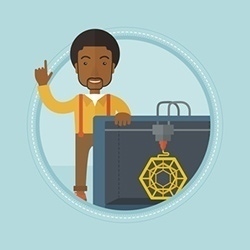3D printing has been poised to transform travel for several years. We’re now seeing the beginnings of 3D printed airplane food, jet engines, cars, and even space station equipment. How will 3D printing improve how we get from one place to another? Here are a few jet-setting innovations happening at the intersection of 3D printing and travel.
Air travel
- Airplane manufacturers are exploring the pros of 3D printing for various mechanical parts. Airbus, for example, announced that its next-generation A350 XWB is using a handful of 3D-printed components. Engineers at GE Aviation have created a 3D-printed jet engine—and taken it all the way to 33,000 RPM.1
- What will tomorrow’s airplane food taste like? Concepts are underway for 3D-printed sky meals made to order for each traveler. Called the Sky Kitchen, it’s an on-demand food system that lets travelers design their own meal on a screen, then have it printed and ready to eat.
- Way in the future, could you imagine printing a new suitcase (and its contents) if you lose your luggage? That’s what Finnish artist Janne Kyttanen is envisioning. In his exhibit “Lost Luggage,” Kyttanen designed an entirely 3D-printed outfit, including shoes and a bag.
- Of course, a 3D-printed luggage tag could prevent your luggage from getting lost at all.
Healthcare away from home
- The medical advances in 3D printing are very important for a traveler who gets sick. Everything from missing pills to a carefully-fitted orthopedic brace could be digitally downloaded from a patient’s files and manufactured at their destination. A recent study predicts that by 2018 the 3D printing market for healthcare will reach $4043 million2—so expect medical advances much earlier than printable luggage or meals.
- Blended Reality, the fusing of our physical and digital worlds, is a versatile concept that can extend to the chemical and biological world. In the convergence of healthcare diagnostics and digital health, it can play a fundamental role in transforming human biology and enabling personalized drug treatments.
Automotive travel
- The automotive industry is hard at work on its own 3D engineering. A recent report suggests that 3D-printing in the automotive industry will generate a combined $1.1 billion by 2019.3
- Take Subaru, which has developed a way to 3D-print a working scale model of a Subaru Impreza WRX boxer engine.
- Other manufacturers are 3D-printing entire cars. Check out the LM3D Swim by Local Motors: It’s an electric car made up of 80% plastic and 20% carbon fiber, and its manufacturer claims it’s highway-ready (once it’s available, of course).4
- Does your car need a spare part? Instead of having your car sit in the local repair shop for days while it’s on order, the shop could simply print up what you need. That’s what Audi is working on. The German car maker is experimenting with metal 3D printing tech that may eventually extend to their production line and authorized dealers.
Space travel
- 3D printing is hugely important to space travel—not only to help our current astronauts on the International Space Station, but also to figure out ways to sustain ourselves for extended periods of time in space or even on other planets.
- NASA’s 3D printer has already manufactured 3D-printed objects in space, paving the way for future innovations. 3D printing at zero-Gs is an important step towards deep space travel.
- Much of 3D printing tech for space is still in the experimental stages, but there are simpler 3D-printed items available on the International Space Station. While the astronauts don’t have fully 3D-printed meals yet, they are able to enjoy freshly-brewed coffee in a 3D-printed cup. Fresh produce is something the astronauts also miss; hopefully they’ll be able to print up fruit someday, too.
Travel is just one of the many arenas getting revolutionized by 3D printing. As one of the biggest innovators in it today, HP recently introduced its line of HP Jet Fusion 3D printers, which use exclusive Multi Jet Technology to break through all of the limitations of current 3D printing: speed, quality, and cost. From innovative home and office 2D printers to revolutionary 3D printers, HP continuously takes creativity and productivity to a whole new dimension.
[1] GE Reports, These Engineers 3D Printed A Mini Jet Engine, Then Took It To 33,000 RPM
[2] Visiongain, The 3D Printing Market For Healthcare Will Reach $4043M In 2018, Predicts New Study
[3] SmarTech Markets, Additive Manufacturing Opportunities In The Automotive Industry: A Ten-Year Forecast
[4] 3D Printing Industry, Top 10 3D printed automotive industry innovations available right now
used with permission from HP Technology at Work













